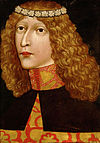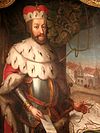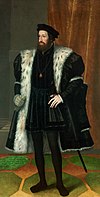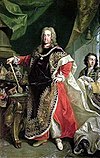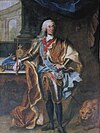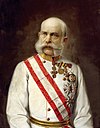List of the Archduke of Austria
Listed here are the ruling archdukes in the Archduchy of Austria, not all the Habsburg or Habsburg-Lorraine princes and princesses who have been the title of the archduke of Austria (Archduke of Austria) from their birth as the title of their princely house, the so-called Erzhaus .
Introduction of the title
On Epiphany 1453, the Habsburg Emperor Friedrich III confirmed. the Austrian charters Rudolf IV. of 1358/1359, a fictitious document with which the Archduke Rudolf title at a time when the Habsburgs the Roman Emperor introduced not yet introduced, de facto. With Frederick III. Sanctuary, the state document later called Privilegium maius became legally binding ( Privilegium minus was called the elevation of Austria to the Duchy of 1156 to distinguish it).
Thus, the then Austria (not to be confused with the later Austrian Empire or today's Republic), until now duchy, received the designation arch duchy and in the Holy Roman Empire a position similar in rank to the electorate . The electoral dignity , the right to elect the Roman king , was not associated with this increase in rank. Friedrichs Mündel, Ladislaus Postumus , was the first to legally hold the title of Archidux Austriae (Arch-Duke of Austria) under imperial law , which was held by the Habsburgs until 1918 and was part of the great title of the Emperor of Austria from 1804 .
Since, according to imperial law, all legitimate male descendants of a prince inherited the same right of rule (even if the actual rule was later focused on the oldest descendants in order to avoid fragmentation), all princes and princesses of the House of Habsburg soon bore the title of archduke. The title Archduke existed worldwide exclusively in this dynasty (see Pragmatic Sanction , Stammliste der Habsburg , Habsburg-Lothringen ).
Dominion of the Archduchy
The term “Austria” had different meanings. He could designate the house of Austria , the ruling dynasty. It was used for the old Habsburg hereditary lands . It could, which was increasingly the case over the centuries, designate their entire territory or, from 1867, its western part, Cisleithanien .
In direct connection with the Archduke title, however, only Austria above and below the Enns (today's Upper and Lower Austria ) with the capital Vienna was meant, the historical core of the Habsburg dominion; only he was to be understood under Austrian law until 1804.
The separation in the country that [he] ( Danube -oberhalb, west) and below , and partly down (east) of the Enns - as a natural spatial organization - initially a province (provincia) and one (land) Place the Enns limited, with a governor / judge, while in the other two parts of Austria, above (north of the Danube) and below (south) the Manhartsberg , a marshal was responsible. The separation becomes political, in the sense of two (arch) duchies, the first time in the fraternal quarrel between Albrecht and Friedrich in the 15th century, then again in the War of the Austrian Succession , when Maria Theresa and Karl Albrecht the Bavarian both speak of an archduchy on the Enns . In 1783, after acquiring the Innviertel, Austria was given its own crown land , still with an unclear state status in relation to archducal dignity, but only finally confirmed in 1861 under the February patent with the status of its own archduchy - the (common) title Archduke of Austria for these two countries (and only this one) will remain in place until 1918, only occasionally is there talk of an archduchy above and below the Enns .
The Archduke who ruled here was for most of the time head of the Habsburg dynasty, monarch of their empire, ruler of their hereditary lands, and especially sovereign in the area of today's federal states of Upper and Lower Austria; as this he bore the title. Since the ruling archduke usually also had the imperial title and was sovereign in all of his countries, his archduke title was of historical and decorative importance. He was more important for his non-ruling family members, who thereby stood out from the vast number of German princes and princesses.
The archdukes as sovereigns of Austria
Before 1457 see: List of Margraves and Dukes of Austria in the Middle Ages
- Among other titles imperial and royal titles are mentioned, but not titles of lower rank as Duke, Duke, Marquis or Count
- Usurpers, conquerors and other counter-rulers are highlighted with a dark gray background, contractually recognized by the respective regent opponents in light gray
- † deceased
- * Immediate assumption of office with the death of the predecessor, as an inheritance claim according to the motto " The king is dead, long live the king "
| image | Surname | gender | more titles | relationship | from | Note | to | Note |
|---|---|---|---|---|---|---|---|---|
| Ladislaus Postumus | Habsburg | King of Bohemia, Hungary (V.) | Son of Albrecht V. | January 6, 1453 | Confirmation of the title, is Duke from birth February 22, 1440 on | November 23, 1457 | † | |
| Friedrich V , the peacemaker | Habsburg | Emperor of the HRR (III.) | Great-nephew of Albrecht III. | November 23, 1457 | *; had previously been interim since October 27, 1439 and as guardian regent since February 22, 1440 (1) | December 26, 1462 | End of the siege of Vienna by Albrecht | |
| Albrecht VI. , the Generous | Habsburg | Archduke since January 6, 1453 | Brother of the predecessor | August 21, 1458 | House contract with Friedrich, assumption of government in Austria. odEnns; | December 2, 1463 | † | |
| December 26, 1462 | Takeover of power in Austria udEnns | |||||||
| Friedrich V (continued term of office) | Habsburg | Emperor of the HRR (III.) | December 2, 1463 | *; resides 1484–1493 in Linz | August 19, 1493 | † | ||
| Matthias Corvinus | Hunedoara | (Counter) King in Bohemia, Hungary | June 1, 1485 | Capture of Vienna, claims the title of duke (beginning of the campaign in 1477) | April 6, 1490 | †; August 29, 1490 Conquest of Vienna by Maximilian | ||
| Maximilian I , the last knight | Habsburg | Emperor of the HRR | Son of Friedrich V. | August 19, 1493 | * | January 12, 1519 | † | |
| Charles I. | Habsburg | Emperor of the HRR (V., 1520–56), King of Spain, bd.Sicily, Hungary etc., d.Balearic Islands, can.u.ind. Islands and beyond the ocean | Grandson of the predecessor | January 12, 1519 | * | April 28, 1521 | Reichstag in Worms , establishment of a Reich regiment, Worms inheritance agreement there | |
| Ferdinand I. | Habsburg | Emperor of the HRR (V, from 1558), King of Bohemia, Hungary (from 1526/27) etc. | Brother of the predecessor | April 28, 1521 | Transfer of reign in the Worms Treaty | July 25, 1564 | † | |
| Maximilian II | Habsburg | Emperor of the HRR, King of Bohemia, Hungary etc. | Son of the predecessor | July 25, 1564 | * | October 12, 1576 | † | |
| Rudolf V. | Habsburg | Emperor of HRR (II.), King of Bohemia, Hungary etc. | Son of the predecessor | October 12, 1576 | * | June 25, 1608 | Peace of love , renouncing Austria. ua., † January 20, 1612 | |
| Matthias [I.] | Habsburg | Emperor of the HRR, King of Bohemia, Hungary etc. | Brother of the predecessor | June 25, 1608 | Peace of Love , September 1578 Beginning of the brotherly quarrel, since 1593 governor in Austria. | March 20, 1619 | † | |
| Ferdinand II. | Habsburg | Emperor of the HRR, King of Bohemia (2) , Hungary etc. | Nephew of Maximilian II. | March 20, 1619 | * | February 15, 1637 | † | |
| Ferdinand III. | Habsburg | Emperor of the HRR, King of Bohemia, Hungary etc. | Son of the predecessor | February 15, 1637 | * | April 2, 1657 | † | |
| Leopold V. [Ignatius] | Habsburg | Emperor of the HRR (I.), King of Bohemia, Hungary etc. | Son of the predecessor | April 2, 1657 | * | May 5, 1705 | † | |
| Joseph I. | Habsburg | Emperor of the HRR, King of Bohemia, Hungary etc. | Son of the predecessor | May 5, 1705 | * | April 17, 1711 | † | |
| Charles II [Franz Joseph] (3) | Habsburg | Emperor of HRR (VI.), King of Bohemia (II.), Hungary (III.) Etc. | Brother of the predecessor | April 17, 1711 | * | October 20, 1740 | † | |
| Maria Theresa | Habsburg / Habsburg-Lothringen | Empress of the HRR (as wife of Franz I Stephan ), Queen of Bohemia, Hungary etc. (4) | Daughter of the predecessor | October 20, 1740 | * | November 29, 1780 | † | |
| Karl [III.] Albrecht | Wittelsbach | Emperor of the HRR (VII., 1742–45), Elector, Duke of Bavaria, (counter) King of Bohemia | October 2, 1741 | Hereditary homage to Linz; November 1740 Ultimatum for recognition of M. Th., War of the Austrian Succession , occupied September 1741 Austria. odEnns and udManhartsberg | April 16, 1742 | Convocation of the Landtag to Linz; January 1742 Recapture of Linz, June 25, 1743 Hereditary homage for M. Th. Zu Prague, † January 20, 1745 | ||
| Joseph II | Habsburg-Lorraine | Emperor of the HRR (since 1765), King of Bohemia, Hungary etc. | Son of Maria Theresa | November 29, 1780 | *; Co-regent since 1763 | February 20, 1790 | † | |
| Leopold VI. | Habsburg-Lorraine | Emperor of HRR (II.), King of Bohemia, Hungary etc. | Brother of the predecessor | February 20, 1790 | * | March 1, 1792 | † | |
| Franz I [Joseph Karl] | Habsburg-Lorraine | Emperor of the HRR (II., Until 1806), Emperor of Austria (I., from 1804), King of Bohemia, Hungary etc. (5) | Son of the predecessor | March 1, 1792 | * | March 2, 1835 | † | |
| Ferdinand IV , the kind | Habsburg-Lorraine | Emperor of Austria (I.), King of Bohemia (V.), Hungary (V.) etc. | Son of the predecessor | March 2, 1835 | * | December 2, 1848 | Government Handover (6) | |
| Franz Joseph (I.) | Habsburg-Lorraine | Emperor of Austria (I.), King of Hungary, Bohemia etc. | Nephew of the predecessor | December 2, 1848 | Handover of government | November 21, 1916 | † | |
| Charles I./IV. [Franz Joseph] (3) | Habsburg-Lorraine | Emperor of Austria (I.), King of Hungary (IV.), Bohemia etc. | Great-nephew of the predecessor | November 21, 1916 | * | November 11, 1918 | Renunciation of government affairs; March 24, 1919 exile, April 10, 1919 expulsion according to Habsburg law , † April 1, 1922 (7) |
After 1918/19 see
- List of Federal Presidents of the Republic of Austria (as Head of State of the Republic)
- List of Austrian provincial governors : Lower Austria, Upper Austria (as provincial head of the two successor territories in the narrower, federal sense)
- Family list of the House of Habsburg-Lothringen: From Charles I on (titular succession) (8)
Remarks
- (1)Friedrich, who had imperially confirmed the title of Archduke and thus made it valid under imperial law, did not use it himself
- (2)From 1618 to 1620 by Frederick V. displaced
- (3)actually III. von Habsburg, but Charles II. Franz , founder of the Inner Austrian line, was ruler only in Inner Austria; of I. Karl (as Emperor V.) was the founder of the Spanish line; the number V was created by counting the Wittelsbacher as IV. Karl
- (4)Maria Theresa was called Empress ; as there was no female line of succession in the Holy Roman Empire, it meant “wife of the emperor”. In the Austrian hereditary lands, Maria Theresa was ruler herself due to the pragmatic sanction . Since there was no female title here either, Maria Theresia traded like her male predecessors and descendants as Archidux Austriae, Bohemiae et Hungariae Rex , i.e. as Archduke and King - to be found on the Maria-Theresien-Taler
- (5)Franz accepted the personal hereditary title of Emperor "of Austria" in 1804 and ruled as Franz I. He laid the Roman-German imperial crown (as Franz II) in 1806, with the end of the Holy Roman Empire, therefore often referred to as Franz II ./I. The word "Austria" in the imperial title denotes the name of our ore house . That is why the new empire was also called the “ Austrian Empire ”, which initially left open whether it meant land or crown (dignity), just as the Holy Roman dignity was an office without any actual land. It only acquired the character of the state name when further imperial dignities were installed elsewhere.
- (6)No abdication ( abdication ); Ferdinand held the imperial title until his death in 1875
- (7)Since there was no formal abdication in 1918, the republic's claim to power lapsed with the abolition of the monarchy on November 12, 1918 and expulsion from the country on April 3, 1919. The Habsburgs themselves renounced individually as persons; the expulsion from the country became dead right in 1996 with the waiver of the last formal title contenders (for details see Habsburg Law ).
See also
- List of Roman-German rulers
- List of the wives of the Roman-German rulers
- The bearers of the title Kaiser von Österreich
Web links
- Austrian Lands before 1918: Austria (Österreich) . Ben Cahoon: worldstatesmen.org , 2000
- Chronicle from 1453 . Automatically generated search page in: History , Lower Austria State Museum
- Important historical dates in key words . (PDF; 1.4 MB) habsburg.net; to the family tree of the Habsburgs
Individual evidence
- ↑ Note: The forms Archduke of Austria and Archduke of Austria can also be found in contemporary literature.
- ↑ In recent research, however, it is assumed that the confirmation of January 6, 1453 was primarily directed against Ladislaus, on this Heinrich Koller: Kaiser Friedrich III. Wissenschaftliche Buchgesellschaft, Darmstadt 2005, p. 134ff, above all 136. This is in any case in contradiction to the fact that Ladislaus is said to have been the first to legally use the title of Archidux Austriae or Archduke of Austria under imperial law.
- ↑ After Eva Bruckner: Forms of representation of power and self-portrayal of Habsburg princes in the late Middle Ages . Vienna, Dissertation, 2009, p. 107, Ladislaus himself did not use the title of Archduke, and there are also no photo documents on which he presents himself with the corresponding insignia. In the few documents he personally signed, he describes himself as “Ladislaus Rex manu propria”.
- ↑ a b December 26, 1462 Archduke Albrecht VI. takes over the government in Austria under the Enns . Lower Austria State Museum.
- ↑ Konstantin Moritz A. Langmaier: Archduke Albrecht VI. of Austria (1418–1463). A prince caught between dynasty, regions and empire (= research on the imperial and papal history of the Middle Ages , volume 38). Böhlau, Cologne a. a. 2015, p. 399 ff.
- ^ Regest 1458 August 21, Wiener Neustadt . Regg.F.III. H. 18 to 37. In: Sonja Dünnebeil, Paul Herold, Kornelia Holzner-Tobisch (arrangement): Regesten Kaiser Friedrich III. (1440-1493). Organized by archives and libraries. H. 18: The documents and letters of the Austrian State Archives in Vienna, Dept. House, Court and State Archives: General series of documents, family documents and collections of copies (1458–1463) . Vienna [u. a.], 2004 (regesten.regesta-imperii.de).
- ↑ a b see list of the sieges of Vienna
- ↑ a b Gustav Otruba : The Hereditary Tributes of the Upper Austrian Estates 1732 - 1741 - 1743. A study on the history of the loyalty of the clergy, nobility and bourgeoisie towards Charles VI, Karl Albert and Maria Theresia. In: Communications from the Upper Austrian Provincial Archives , Volume 16, 1990, III. The death of Charles VI, the Pragmatic Sanction, the Wittelsbachers' inheritance claims and the hereditary homage (1741). Pp. 161-191; IV. The reconquest of the country Ob der Enns by Khevenhüller's royal troops and the punishment of the faithless. Pp. 191-204; V. From the files of the investigative commission: Appeals for clemency and letters of justification. Pp. 204–191 [total amount pp. 135–301], entry with PDFs for download in the forum OoeGeschichte.at
- ^ Proclamation of August 11, 1804

